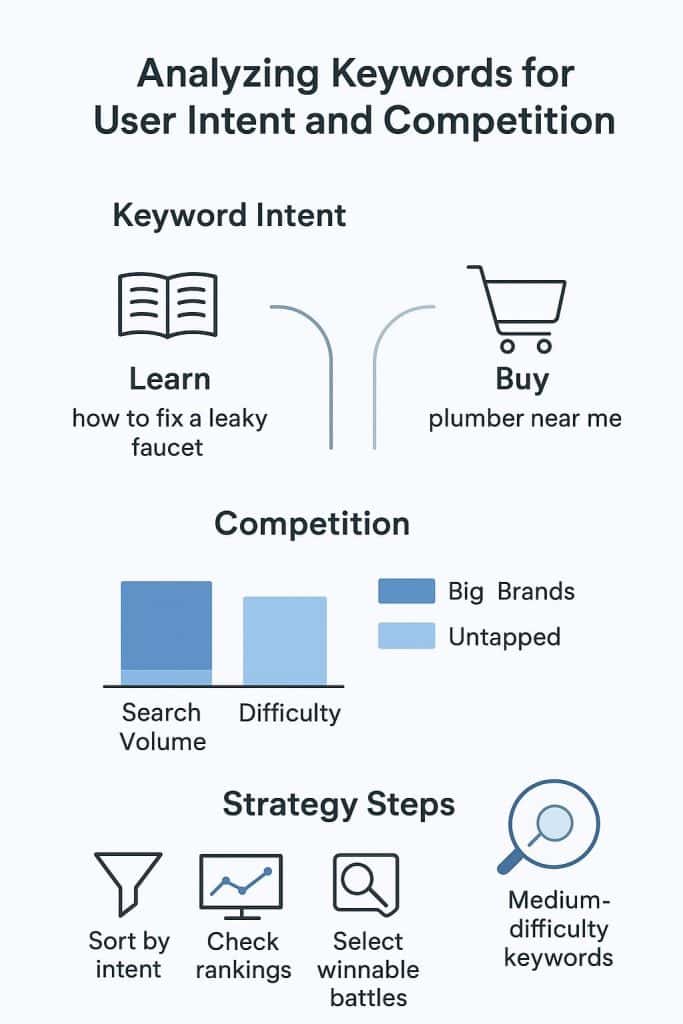
Finding the right search terms makes the difference between content that gets buried and content that gets read. When you think about a keyword research content strategy, this becomes even more clear. It’s not just about guessing what people type into a search engine, it’s about knowing how to use those search terms to shape your content so it reaches the right audience.
Keyword research content strategy is not about cramming keywords or chasing big numbers. Instead, it’s about really understanding what drives people to type those words into Google at 2 AM. In fact, 73% of B2C marketers and 78% of B2B marketers use keyword research to inform their content creation (1).
Sure, the data from fancy tools helps, but nothing beats actually understanding how real people look for answers online. Want to know how keyword research can transform your content from ignored to impossible to ignore? Keep reading.
Key Takeaways
- Getting your keywords right means nothing if they don’t match what your business needs and what your readers want
- Looking at why people search for stuff, plus what the competition’s doing, helps pick better keywords
- Keywords work best when they flow with the writing. Nobody wants to read something that sounds like a robot wrote it
Defining Goals and Understanding Audience

Getting keywords right starts with knowing what you’re really after. Companies love throwing around big terms like “boost traffic” or “increase engagement,” but that’s not specific enough. Sometimes it takes a closer look at an overall seo content strategy to see how goals connect with the audience in real ways.
A small business selling handmade jewelry probably cares more about getting actual buyers than racking up page views. The next piece is figuring out exactly who’s looking for what you’ve got. Take that jewelry business. Their ideal customer might be a 35 year old professional who searches “unique handmade necklaces” during lunch breaks.
They’re probably comparing prices on their phone, reading reviews, and checking Instagram for style ideas. Real people, real habits.
Here’s what needs sorting out:
- Pick one main goal (more sales, more subscribers, whatever makes sense)
- Get specific about who you’re trying to reach
- Figure out how these people actually search
- Match your keywords to their habits
Getting this foundation right makes everything else easier. No point chasing keywords that look good on paper if they don’t connect with the people who might actually buy something. And yeah, sometimes that means ignoring the high-volume keywords everyone else is fighting over.
Brainstorming and Using Research Tools
Starting a keyword list feels a lot like mapping out a family tree. You’ve got those big obvious terms everybody knows. The grandparents, if you will. But it’s the extended family. Those longer, more specific phrases. That often lead to the good stuff.
The process usually starts with writing down every obvious term that comes to mind. Customer emails, support tickets, even complaints. They’re all gold mines for how people actually talk about what you’re selling. Then it’s time to plug these starter words into tools like Google’s Keyword Planner (still free, thankfully) or SEMrush if you’ve got the budget.
What to do next:
- Write down every obvious term in your field
- Check what customers are saying in their own words
- Pop those terms into research tools
- Look for those longer phrases that don’t get as much attention
- Keep an eye out for questions people are asking
Here’s the thing about those longer keyword phrases. They might only get searched 100 times a month instead of 10,000, but the people searching for them usually know exactly what they want. Sometimes those smaller numbers lead to bigger results.
Analyzing Keywords for User Intent and Competition

Looking at keywords without thinking about why people search for them is like buying shoes without checking the size. The numbers might look good, but they won’t get you where you need to go. Some folks type “how to fix a leaky faucet” because they want to learn, while others search “plumber near me” because they’re ready to hire.
Competition’s another thing entirely. Sure, “best running shoes” might get tons of searches, but trying to outrank Nike and Adidas? Good luck with that. Smart content planners look for those sweet spots. Terms where big brands haven’t bothered to create good content yet.
Here’s the game plan:
- Sort keywords by what people actually want
- Check who’s already ranking for each term
- Look for gaps where the big players dropped the ball
- Pick battles you can actually win
Just remember. It’s not always about the highest search volume. Sometimes the best opportunities are hiding in those medium-difficulty keywords where nobody’s really nailed the content yet. That’s where the real wins happen.
Using Real Words Real People Search For
Building content feels a lot like hosting a dinner party. You’ve got to serve what people actually want to eat. Most websites mess this up by trying to sound too fancy or professional, forgetting that their readers are probably scrolling through their phones while waiting for coffee.
In fact, as of July 2025, mobile devices account for 64.35% of global web traffic, a significant increase from just 6.1% in 2011 (2). This shift underscores the importance of creating content that’s easily digestible on small screens and quick to consume.
Setting up a content calendar makes life easier. It’s basically a roadmap saying what gets published when, and in what format. Some topics need a deep-dive blog post with charts and examples. Others work better as a quick how-to video. The key is matching the format to what makes sense for the reader.
What makes content click:
- Pick topics your business actually knows about
- Choose the right format (article, video, podcast)
- Set real deadlines and stick to them
- Write like you’re explaining it to a friend
The biggest mistake? Making everything sound like it came from an AI writing assistant. Real people don’t talk like that. They use normal words, make little grammar mistakes, and definitely don’t say things like “leverage your core competencies.” When in doubt, read it out loud. If it sounds weird coming out of your mouth, it probably needs another edit.
Content That Gets Found
People don’t care about yesterday’s news. Everyone talked about “quiet quitting” for like five minutes, and now? Gone. Vanished. Just another forgotten hashtag. Smart content folks know this, so they watch Google Trends like a hawk, often using tools like human AI editors for on-page SEO to quickly adapt their content to trending topics. Gotta stay ahead of what’s next.
Look, writing something brilliant isn’t enough anymore. Trust me on this one. Even the most amazing content needs a little push out the door, kinda like that incredible taco place nobody knows about yet. Without some help, it’ll just sit there. Waiting.
And you know what actually works? Getting other sites to notice you. Building real connections. When someone links to your stuff, search engines pay attention. It’s pretty simple really. Email newsletters still work too, surprisingly well actually. Social media can help, if you’re smart about it.
What you should probably do:
- Watch those trends (but don’t go crazy)
- Listen when people ask questions
- Update the old stuff that’s getting dusty
- Show up where your readers actually are
- Make friends with other sites in your space
Here’s the thing though. Content needs love. Lots of it. You can’t just write something and walk away, hoping it’ll somehow find its audience. Sometimes you gotta trim away stuff that isn’t working. Other times you just need to add fresh examples or new numbers. But that’s just how it goes.
Bottom line? Nothing stays fresh forever. Not content, not trends, not anything really. Just keep watching, keep updating, keep connecting. That’s what works.
Real Talk About Writing

We’ve all seen those articles. You know the ones. They repeat the same word so many times you start counting instead of reading. Brutal. Search engines got smart years ago, but some writers still haven’t caught up. They stuff keywords everywhere like they’re getting paid by the word.
Ya know what actually works? Writing like you’re talking to someone sitting across from you at coffee. Tell them about that time your client doubled their traffic in three months. Show them the graph that proves it. Make it real.
Nobody wants to read robot speak. Seriously. When I see an article packed with the same phrase fifteen different ways, I close the tab. Done. And guess what? Google doesn’t like that stuff either. That’s why a human editor often makes the difference, polishing drafts for better flow and natural AI readability.
Are You a Digital Agency?
White Label SEO Content Services for Agencies
Scalable, customizable, and results-driven content solutions for your clients.
What makes content worth reading:
- Natural keywords sprinkled in (like, maybe 1%)
- Different words that mean the same thing
- Pictures and charts people actually get
- Stories that stick with you
Look, at the end of the day, writing good content isn’t rocket science. Just write stuff you’d actually want to read. Answer real questions. Solve actual problems. Maybe throw in something that makes somebody grin.
And those keywords everybody obsesses over? They’re just salt and pepper. Use em light. The meat of your content matters way more.
Why Jet Digital Pro Stands Out in SEO Content
After dealing with dozens of content providers over the years, most fall into the same trap. Churning out generic articles that sound like they came straight from ChatGPT. Jet Digital Pro caught our attention by doing something different. They’ve figured out how to blend tech tools with real writers who actually understand what makes content work.
Their team knows the headaches agencies face. Nobody wants to explain to clients why their blog posts sound robotic or why they’re getting flagged as AI generated. That’s probably why they put so much effort into making sure everything sounds natural. Like it was written by someone who actually knows what they’re talking about.
They handle pretty much everything you’d need:
- Blog posts that don’t sound like robots wrote them
- SEO tweaks that actually make sense
- Link building that doesn’t feel spammy
- Custom packages that fit what agencies actually need
The best part? While they’re busy making the content magic happen, agencies can focus on what they do best. Keeping clients happy and growing their business. No more late nights editing generic articles or struggling to meet content deadlines.
FAQ
How do long tail search terms help improve my marketing strategy?
Long tail search terms make it easier to match what people actually type into a search engine. By focusing on tail keywords instead of only broad search terms, you raise your chance of ranking higher. This approach can guide your overall marketing strategy and make your content more helpful to readers.
What role do social media and email marketing play in a keyword research content strategy?
Social media and email marketing can show you which search terms people use most often. By studying this, you can find new tail keywords to include in your content. This not only boosts organic traffic but also supports a stronger digital marketing plan.
How can I use google search and other search engines for keyword research?
Need a Strategic SEO Content Partner?
Let’s craft SEO content that ranks, converts, and grows your brand.
Talk to UsGoogle search and other search engines show what people are looking for every day. Studying these search terms helps you spot long tail keywords with a higher chance of ranking. You can then use this information when creating content that fits naturally into your marketing strategy.
Why is google analytics important for finding good search terms?
Google analytics tracks which search terms bring in organic traffic. It also shows which long tail keywords are driving results. By checking this data, you can adjust your digital marketing plan and decide where creating content will work best to support your overall marketing strategy.
How does creating content with long tail keywords help build organic traffic?
Creating content around long tail keywords gives you a better chance of ranking on search engines. These search terms often face less competition, which makes it easier to draw steady organic traffic. Over time, this strategy strengthens your digital marketing and keeps your audience engaged.
Conclusion
Finding the right keywords sets everything else in motion. It’s not about following some rigid formula. It’s about understanding what makes people click and stick around. At Jet Digital Pro, we’ve turned this into a science that still feels human.
Our approach combines smart tech with real writers who get what agencies need. The result? Content that ranks well and reads even better. No fluff, no keyword stuffing, just stuff that works. Ready to scale your content without the hassle? Let’s talk about making your content work harder.
Related Artifcles
- https://jetdigitalpro.com/understanding-seo-content-strategy-service/
- https://jetdigitalpro.com/human-editor-enhances-ai-readability/
- https://jetdigitalpro.com/human-ai-editor-for-on-page-seo/
References:
- https://www.expertmarket.com/digital-marketing/b2c-content-marketing-statistics
- https://explodingtopics.com/blog/mobile-internet-traffic
P.S – Whenever you’re ready,
we’re here to help elevate your SEO content.
Partner with us for strategic, scalable content that drives real organic growth.
Contact Us Now



